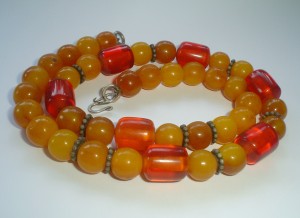A while ago I found this necklace (below) in a charity shop. I gently cleaned it using an old toothbrush, unscented soap and tepid water. It’s come up looking very nice and the appearance of the beads, together with the style of the findings (which are sterling silver), makes me think that the necklace is more than a few decades old.
On looking at the egg yolk yellow, round beads, my first thoughts were “amber”, followed by “Bakelite”. But I was puzzled by the clear orange barrel-shaped beads – obviously they are some kind of plastic, but what? I put the necklace away and several months later while randomly searching the Internet, I hit on what I thought might be the answer when I found the site Gale’s Bakelite Guide. The orange barrels could be made of something called Prystal, a clear form of Bakelite that was manufactured in several colours.
The Guide also lists several ways to test for Bakelite, the most reliable non-chemical one of which is to run the item under hot water. A formaldehyde smell is a positive result, while no smell at all suggests that your item isn’t made of Bakelite at all but some other plastic like lucite/acrylic.
I duly ran the necklace under the tap. Was there a smell? No. So I am listing it on Etsy as “vintage plastic”.

